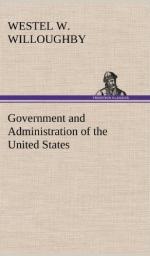All peoples have not the same characteristics, nor have they developed under the same conditions of climate, soil or situation. Different nations have, therefore, developed for themselves different forms of government. Yet these governments, however different in their structures and administration, are in all cases distinctly referable to four well defined types: Monarchy, Aristocracy, Democracy, and the Republic. _#Monarchy.#_—A monarchy is a nation at whose head is a personal ruler, called King, Emperor, or Czar, who has control of the government, appoints the principal officers of state, and to whom in theory at least, these appointees are responsible for their actions. Thus England, Germany, Spain, Italy, Sweden, and others are monarchies. The sovereign holds his position for life, and usually acquires his throne by inheritance. Where the crown is nominally elective, as in England, kingship is practically hereditary, the regular line of descent being departed from only upon rare occasions.
The amount of power actually exercised, the responsibility borne by the sovereign varies widely in different countries, and upon the basis of these differences monarchial forms of government are classified under the two heads, Absolute and Limited Monarchies.
_#An Absolute Monarchy.#_—An absolute monarchy is one in which the sovereign or ruler is possessed of supreme power and authority, and controls absolutely, without limitation or interference, all the powers of government. His word is law and requires not the sanction of the people. His commands are absolute and require not the formality of judicial procedure, and are not necessarily in conformity with existing laws. Implicit obedience to his commands, however arbitrary, may be demanded, and there is no appeal. These are, theoretically, the powers of the absolute monarch. Practically, however, he is constrained to keep within fair bounds of justice and good policy, lest his subjects be goaded to rebellion and revolution. The absolute form of monarchy exists to-day in the empires of Russia and Turkey.
_#A Limited Monarchy.#_—A limited monarchy is one in which the ruler, though at the head of the government, is not absolute, but is limited in his powers by the action of a body of men, selected by the people, who make the laws by which the nation is to be governed. The respective rights and powers of the sovereign and of the law-making body, are determined by a collection of rules, written or unwritten, collectively known as the constitution. The constitution contains the fundamental law of the land. All acts of the government to be valid, must be constitutional, that is to say, in conformity with the rules laid down in the constitution. For this reason limited monarchies are also known by the name of Constitutional Monarchies.
England is the most conspicuous example of a limited or constitutional monarchy. In consideration of our former connection with her, and the extent to which we have derived our ideas of government from her political institutions, it will be of great assistance to us if we stop for a moment to consider her government, before proceeding to a study of our own.




